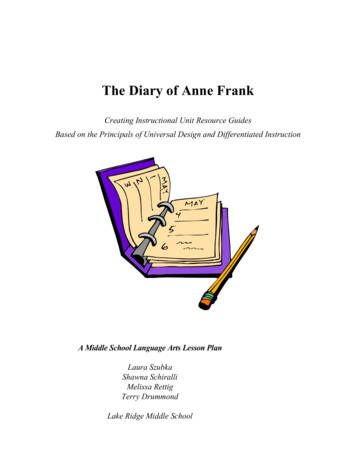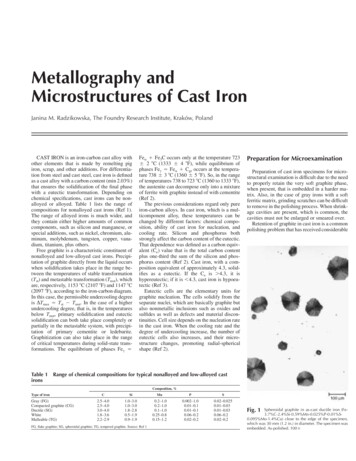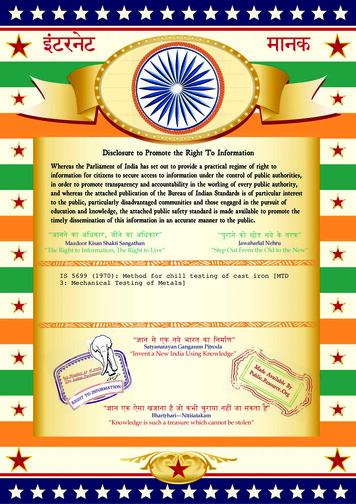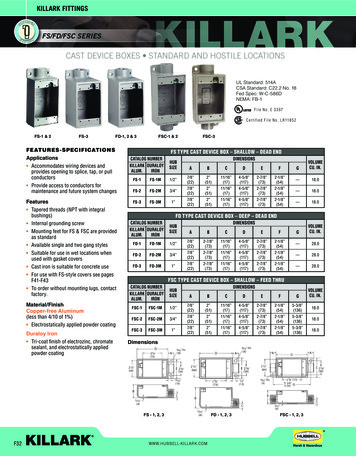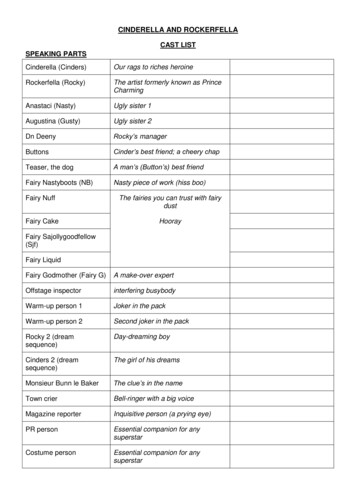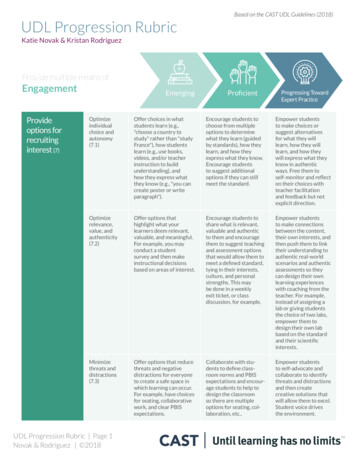
Transcription
Based on the CAST UDL Guidelines (2018)UDL Progression RubricKatie Novak & Kristan RodriguezProvide multiple means ofEngagementProvideoptions forrecruitinginterest (7)EmergingProficientProgressing TowardExpert PracticeOptimizeindividualchoice andautonomy(7.1)Offer choices in whatstudents learn (e.g.,"choose a country tostudy" rather than "studyFrance"), how studentslearn (e.g., use books,videos, and/or teacherinstruction to buildunderstanding), andhow they express whatthey know (e.g., "you cancreate poster or writeparagraph").Encourage students tochoose from multipleoptions to determinewhat they learn (guidedby standards), how theylearn, and how theyexpress what they know.Encourage studentsto suggest additionaloptions if they can stillmeet the standard.Empower studentsto make choices orsuggest alternativesfor what they willlearn, how they willlearn, and how theywill express what theyknow in authenticways. Free them toself-monitor and reflecton their choices withteacher facilitationand feedback but notexplicit direction.Optimizerelevance,value, andauthenticity(7.2)Offer options thathighlight what yourlearners deem relevant,valuable, and meaningful.For example, you mayconduct a studentsurvey and then makeinstructional decisionsbased on areas of interest.Encourage students toshare what is relevant,valuable and authenticto them and encouragethem to suggest teachingand assessment optionsthat would allow them tomeet a defined standard,tying in their interests,culture, and personalstrengths. This maybe done in a weeklyexit ticket, or classdiscussion, for example.Empower studentsto make connectionsbetween the content,their own interests, andthen push them to linktheir understanding toauthentic real-worldscenarios and authenticassessments so theycan design their ownlearning experienceswith coaching from theteacher. For example,instead of assigning alab or giving studentsthe choice of two labs,empower them todesign their own labbased on the standardand their scientificinterests.Minimizethreats anddistractions(7.3)Offer options that reducethreats and negativedistractions for everyoneto create a safe space inwhich learning can occur.For example, have choicesfor seating, collaborativework, and clear PBISexpectations.Collaborate with students to define classroom norms and PBISexpectations and encourage students to help todesign the classroomso there are multipleoptions for seating, collaboration, etc.Empower studentsto self-advocate andcollaborate to identifythreats and distractionsand then createcreative solutions thatwill allow them to excel.Student voice drivesthe environment.UDL Progression Rubric Page 1Novak & Rodriguez 2018
Provide multiple means ofEngagementProvide optionsfor sustainingeffort andpersistence (8)EmergingHeightensalience ofgoals andobjectives(8.1)Vary demandsand resourcesto ity(8.3)Increasemasteryorientedfeedback(8.4)UDL Progression Rubric Page 2Novak & Rodriguez 2018ProficientProgressingToward ExpertPracticeBuild in “reminders”of both goals and theirvalue. For example,write standards on theboard and/or at thetop of assessments andprojects.Encourage studentsto collaborativelydiscuss goals in light ofstudents' own passionsand interests and tochoose from variousoptions to reach thegoals.When given thelearning standard,have students createpersonal goals for howthey will learn thecontent, express thecontent, and challengethemselves throughoutthe process.Provide options forstudents to learn contentwith clear degrees ofdifficulty. For example,"Explore one of thefollowing resources tolearn about the CivilWar." and there may be arigorous primary sourcedocument and a video.Provide multiple optionsfor students to learncontent with cleardegrees of difficultywhich will requirethem to reflect on thestandard and their ownstrategy for learning.For example, "Choosetwo of the followingsix resources to learnabout the Civil War."and there may berigorous primary sourcedocuments, summarydocuments, videos, and/or a podcasts from aprofessor.Empower studentsto select their owncontent and/or ownassessments, basedon standards, andencourage them tocollaborate to add tothe multiple optionsoffered to challengethemselves andidentify appropriateresources that connectto their interests andpassions.Provide opportunitiesfor students to learnhow to work effectivelywith others. For example,create cooperativelearning groups withclear goals, roles, andresponsibilities.Develop a classroomthat values collaborativegroupwork. Studentsconstruct their owngroups and create theirown group norms,responsibilities, etc. andstudents often seek outand work with diversepartners.Create a classroomculture where studentswork together todefine goals, createstrategies, providefeedback to each otherand push each otherwith mastery-orientedfeedback whilebuilding integrativethinking.Provide feedbackthat guides learnerstoward mastery ratherthan a fixed notionof performance orcompliance. For example,provide feedback thatencourages the use ofspecific supports andstrategies in the face ofchallenge.In addition to providingemerging feedback,empower studentsto provide masteryoriented feedback toeach other to supportspecific improvementand increased effort andpersistence.Implement proficientpractice and alsoempower studentsto use masteryoriented feedbackindependently toself-reflect, self-direct,and pursue personalgrowth in areas ofchallenge.
Provide multiple means ofEmergingEngagementProvide optionsfor selfregulation (9)Promoteexpectationsand beliefsthat optimizemotivation(9.1)Facilitatepersonalcoping skillsand strategies(9.2)Develop selfassessmentand reflection(9.3)UDL Progression Rubric Page 3Novak & Rodriguez 2018ProficientProgressingToward ExpertPracticeTeach students about thepower of perseveranceand use language andfeedback that will allowall students to seethemselves as capablelearners.Foster conversationswith students to developrelationships and makeauthentic connectionsand use their personalpassions and intereststo help inspire themand push them towardsuccess.Create a classroomculture where studentsare empowered andable to support theirown self-talk andsupport one another'spositive attitudestoward learning.Offer reminders, models,and tools, to assistlearners in managing anddirecting their emotionalresponses. For example,use stories or simulationsto demonstrate copingskills. Offer optionsfor stress release suchas alternate seating,fidget tools, mindfulnessbreaks, etc.Empower studentsto deal with difficultchallenges by allowingthem to choose frommultiple strategies toregulate their learning(e.g., a relaxation corner,put on headphones, takea walk).Encourage students toself-reflect, accuratelyinterpret their feelings,and use appropriatecoping strategies andskills to foster learningfor themselves andtheir classmates.Provide studentswith tools so they arereflecting on theirlearning through rubrics,self-assessment, etc.Offer multiplemodels and scaffoldsof different selfassessment techniquesso students can identifyand choose onesthat are optimal. Forexample, these mightinclude ways to collect,measure, and displaydata from their ownbehavior and academicperformance for thepurpose of monitoringgrowth.Create a culture wherestudents consistentlyreflect on thelearning process andassessments so theybecome self-directedlearners who growover time.
Provide multiple means ofRepresentationProvideoptions forperception (1)Offer ways ofcustomizingthe display ofinformation(1.1)Offeralternativesfor auditoryinformation(1.2)Offeralternativesfor visualinformation(1.3)UDL Progression Rubric Page 4Novak & Rodriguez 2018EmergingProficientProgressingToward ExpertPracticeCreate resources andmaterials that addressvariability and meet theneeds of more students(e.g., large size print,additional white space,visuals).Create resourcesand materials thatstudents can accesselectronically. Allowstudents to use theirdevices to interact withtextual, visual and audioinformation so they canpersonalize, take notes,increase/decrease size/volume, etc.Empower studentsto choose resourcesand materials thatbest meet their needs(e.g., watch a video ORexplore a handout) sothey can personalizetheir learningthemselves withoutexplicit direction froma teacher.Provide an embeddedoption for anyinformation presentedaurally. For example, useclosed-captions whenplaying a video.Provide multipleoptions for students tochoose alternatives tolearn content so theydon't have to rely onauditory information(e.g., closed captions forvideo or the choice ofreading a text).Empower studentsto select auditoryalternatives as well asprovide them with aframework to locateadditional, reputableresources to buildtheir understanding(e.g., resources onhow to determine if awebsite or author iscredible).Provide an embeddedoption for students sothey don't have to relyon visual information.For example, readingaloud to the class whilethey read along.Provide multipleoptions for students tochoose alternatives tolearn content so theydon't have to rely onvisual information (e.g.,listen to audiobookinstead of reading orchoose to work withteacher for short presentation).Empower students toselect alternatives tovisual information aswell as provide themwith a frameworkto locate additional,reputable resourcesto build their understanding (e.g.,resources on how todetermine if a websiteor author is credible).
Provide multiple means ofRepresentationProvideoptions forlanguage,mathematicalexpressions,and symbols (2)Clarifyvocabularyand symbols(2.1)Clarify syntaxand structure(2.2)Supportdecodingof text,mathematicalnotation, andsymbols(2.3)Promoteunderstanding (2.5)UDL Progression Rubric Page 5Novak & Rodriguez 2018EmergingProficientProgressingToward ExpertPracticeTranslate idioms, archaicexpressions, culturallyexclusive phrases, andslang. For example, explicitly teach vocabularyto students using definitions, visuals, explanations, and examples.In addition to emergingpractice, providestudents with explicitinstruction in contextclues so they canindependently learnwords unfamiliar tothem.Empower students touse available resourcesto work collaborativelyto determine authenticways to use relevantvocabulary.Clarify unfamiliar syntax(in language or in mathformulas) or underlyingstructure (in diagrams,graphs, illustrations,extended expositions ornarratives). For example,highlight the transitionwords in an essay.Provide students withresources that willallow they themselvesto clarify syntax andstructure (such asdictionaries, mathreference sheets,thesaurus, etc.)Empower studentsto preview materialunder study, highlightareas in need ofclarification, andchoose appropriateresources to buildknowledge andunderstanding.Provide directinstruction, prompts,and scaffolded materialsfor students whostruggle to comprehendinformation. Or providealternatives, such asvisuals, to support thisunderstanding.Provide strategies andmaterials (e.g., mathreference sheets,context clue strategies,and so forth) that lowerbarriers to understandand help students figureout notations, symbols,or problems.Empower students toindependently utilizelearned strategiesto decode text,mathematical notation,and symbols.Provide alternativepresentations of material, especially for keyinformation or vocabulary. For example, makekey information in thedominant language (e.g.,English) also availablein the first languages oflearners with limited-English proficiency. Also,use images AND words,show opposites, etc.Provide students withaccess to tools suchas apps, websites, anddictionaries to translatematerial under studyand to collaborativelybuild understanding.Empower students toindependently utilizeoptions to translatematerial under study,collaborate to buildunderstanding usingtools, apps, etc.Present key conceptsin one form of symbolicrepresentation (e.g.,an expository text or amath equation) with analternative form (e.g.,an illustration, diagram,video, etc.)Present studentswith multipleoptions and symbolicrepresentations to makemeaning and allow themto choose options tobuild comprehension.Empower studentsto choose effectiveresources frommultiple optionswith multiplerepresentations sonot all students arerequired to learn fromthe same resources.
Provide multiple means ofRepresentationProvideoptions forcomprehension(3)Activateor iticalfeatures, bigideas, sualization,andmanipulation(3.3)Maximizetransfer andgeneralization(3.4)UDL Progression Rubric Page 6Novak & Rodriguez 2018EmergingProficientProgressingToward ExpertPracticeProvide all students withbackground informationon content using directinstruction with optionsfor visuals, audio, etc.Provide students withoptions that supply oractivate relevant priorknowledge, or link to theprerequisite informationelsewhere. For example,use advanced organizers(e.g., KWL methods,concept maps) and thenencourage students toselect resources thatwill allow them to buildappropriate backgroundknowledge.Empower studentsto determine gaps intheir own backgroundknowledge and thenselect appropriateresources to build thatknowledge in order toachieve the goals of alesson. For example,begin with a diagnosticassessment and askstudents to reflectand create a strategyfor filling in gaps inlearning.Provide explicit cuesor prompts to helpstudents recognize themost important featuresin information. Forexample, teach studentsto use outlines, graphicorganizers, highlighters,etc.Provide students withoptions and multiplestrategies to supportrecognition of the mostimportant featuresin information. Forexample, allow themto use outlines, graphicorganizer, highlighter,word cloud apps, andother organizing tools.Empower studentsto self-reflect todetermine the mosteffective strategiesfor highlighting criticalinformation and independently select thestrategies that allowthem to support recognition of patterns, critical features, big ideas,and relationships.Provide all studentswith materials,strategies, and toolsto support processingand visualization. Toolsinclude manipulatives(i.e, counting cubes),glossaries, graphicorganizers, and more.Provide students withoptions of multiplematerials, strategies,and tools to use tosupport processing andvisualization, such as theoption to make visualnotes, use technologyto locate images, and/orselect and use manipulatives, etc.Empower studentsto self-reflect andindependently choosethe most appropriatematerials, strategies,and tools to guide information processing,visualization, and manipulation, searchingfor additional tools andstrategies, if necessary.Model explicit strategiesstudents can use to transfer the information theyhave to other contentareas and situations. Forexample, show how theknowledge could be usedin another class or beused to make comparisons across content inthe class (such as text totext comparisons).Provide options formeaningful transfer,such as interdisciplinaryprojects, wherestudents can makeauthentic connectionsand apply knowledgein meaningful ways inother content areas andin authentic situations.Encourage studentsto apply knowledgeand skills learnedin class to enhancetheir understandingof content, design oftheir own authenticprojects, and expresstheir knowledge andunderstanding inauthentic, real-worldscenarios.
Provide multiple means ofAction & ExpressionProvideoptions forphysicalaction (4)Provideoptions forexpressionandcommunication (5)EmergingProficientProgressingToward ExpertPracticeVary themethods forresponse andnavigation(4.1)Provide more than one optionfor the methods used forresponse and navigation withinthe same assignment. Forexample, some students mayuse IPads while others write byhand.Provide multiple options forthe methods used for responseand navigation within the sameassignment. For example, somestudents may use IPads, different writing utensils, keyboards,voice recognition software, etc.Empower students to usetheir own devices to respondto and interact with materialsfor all assignments (e.g.,options to use headphones,keyboards, manipulatives,joysticks, etc.).Optimizeaccess to toolsand assistivetechnologies(4.2)Allow some students to useassistive technologies fornavigation, interaction, andcomposition if required by anIEP or 504.Provide multiple options forall students to use assistivetechnology like IPads, voicerecognition, and 1:1 devicesregardless of variability.Empower students to assessthe need for and choosetechnologies that work forthem to provide additional,personalized options toexpress their knowledge andskills.Use multiplemedia forcommunication(5.1)Provide more than one wayto answer on assessments sostudents can express theirunderstanding without barriers.Taking a traditional test may beone option, but so, too, could bean oral presentation or writingan essay.Provide students with multiple options to express theirunderstanding--and let themsuggest some ways of being assessed, so they understand thatshowing what they know is thepoint rather than how well theyperform on a particular kind oftest. Students may choose toexpress their understanding intext, audio, video, multimedia,live presentations, and manyother ways.Let students reflect ona standard or a set ofcompetency or proficiencybased rubrics, and thenindependently createauthentic and innovativeproducts that allow them todemonstrate their mastery ofthe standard.Use multipletools forconstructionandcomposition(5.2)Provide the choice of morethan one tool or strategy tohelp students express theirknowledge. For example,allow students to composea response using traditionalpen and paper or allowthem to create a multimediapresentation on their device.Provide multiple tools andstrategies to help studentsexpress their knowledge.For example, allow studentsto compose a responseusing traditional writtenmethods, blogging software,or multimedia tools such asThingLink or Emaze.When provided with a task,or when independentlycreating an authenticproduct, students areempowered to self-reflectand select tools and materialsthat will support theirlearning and challenge themto strive for rigorous optionsto express knowledge andskills in accessible, engagingways using, and then buildingupon, the tools they wereexposed to in class.Build fluencieswith graduatedlevels ofsupport forpractice andperformance(5.3)Implement a scaffoldingmodel from teacher-directedto collaborative groups toindependent work, slowlyreleasing responsibility tostudents. For example, incollaborative work, assignteam members specific tasksand monitor their progressbefore moving to independentwork or move from teacherdirected instruction to Socraticseminars.Provide options for supportand scaffolding throughout thelearning process and encouragestudents to choose resourcesthat allow them to build theirown knowledge while workingin collaborative groups andworking independently. Incollaborative groups, forexample, encourage studentsto self-select roles; in classdiscussions, have studentscollaborate to design the rulesand structures.Empower students to createchallenges that let themproductively struggle toreach rigorous goals anduse supports as tools to helpthem to make improvementsrather than making things"easier." Encourage studentsto provide feedback anddrive teacher instruction;encourage them to defineroles and expectations forgroup work that includeroutine monitoring andreflection.UDL Progression Rubric Page 7Novak & Rodriguez 2018
Provide multiple means ofAction & ExpressionProvideoptions forexecutivefunctions (6)EmergingProficientProgressingToward vide clear goals tostudents so it's clear whatthey must do to meet orexceed expectations. Forexample, post standardson the board and onassignments, and articulatethose standards and goalsthroughout the lesson.Create conditions forlearners to develop goalsetting skills. For example,provid
learning through rubrics, self-assessment, etc. Offer multiple models and scaffolds of different self-assessment techniques so students can identify and choose ones that are optimal. For example, these might include ways to collect, measure, and display data from their own behavior and a
